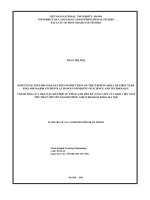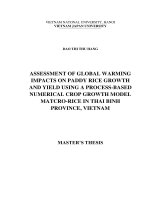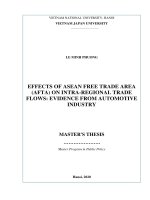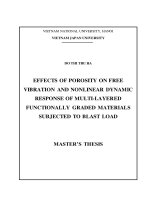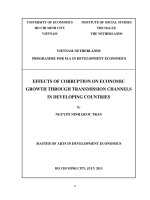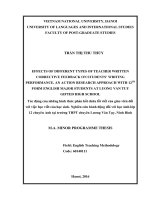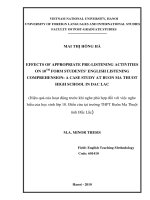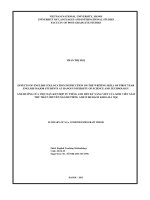Luận văn thạc sĩ effects of using mind mapping on EFL high school students vocabulary learning
Bạn đang xem bản rút gọn của tài liệu. Xem và tải ngay bản đầy đủ của tài liệu tại đây (3.16 MB, 109 trang )
MINISTRY OF EDUCATION AND TRAINING
QUY NHON UNIVERSITY
NGUYỄN THỊ LAN PHƢƠNG
EFFECTS OF USING MIND MAPPING ON EFL
HIGH SCHOOL STUDENTS’
VOCABULARY LEARNING
Field: Theory and Methodology of English Language Teaching
Code: 8140111
Supervisor: TRƢƠNG VĂN ĐỊNH, Ph.D
BỘ GIÁO DỤC VÀ ĐÀO TẠO
TRƢỜNG ĐẠI HỌC QUY NHƠN
NGUYỄN THỊ LAN PHƢƠNG
TÁC ĐỘNG CỦA SƠ ĐỒ TƢ DUY ĐẾN VIỆC HỌC
TỪ VỰNG TIẾNG ANH CỦA HỌC SINH TRUNG
HỌC PHỔ THƠNG
Ngành: Lý luận và phƣơng pháp dạy học bộ mơn tiếng Anh
Mã số:
8140111
Ngƣời hƣớng dẫn: TS. TRƢƠNG VĂN ĐỊNH
i
STATEMENT OF AUTHORSHIP
The thesis entitled “Effects of Using Mind Mapping on EFL High
School Students’ Vocabulary Learning” is conducted under the supervision
of
Dr. Truong Van Dinh, a lecturer working at the School of Foreign
Languages at Quy Nhon University.
I declare that the information reported in this study is the result of my
own work and effort, except where due reference is made. No other person's
work has been used without due acknowledgement in the thesis.
This thesis has not previously been submitted for the award of any
degree or diploma in any other tertiary institution.
Binh Dinh, 2022
NGUYEN THI LAN PHUONG
ii
ACKNOWLEDGEMENTS
First of all , I am grateful to my thesis supervisor, Dr. Truong Van Dinh,
for his amazing supervision. His outstanding knowledge and profession
teaching-related expertise inspired me greatly during my academic life at Quy
Nhon University, and he opened new horizons for me in the field. I appreciate
his accommodating guidelines and suggestions, great patience, and strong
management skills in helping me resolve the obstacles during the time I
carried out my thesis. I feel fortunate to have had him support for my work.
I also take this opportunity to express gratitude to all the lectures who
took part in the training process of MA course at Quy Nhon University for
their scholarly knowledge and experience as well as their inspirational to me
which incited me to widen my research from various perspectives.
A special thank goes to my dear friends Nguyen Thi Hang and Nguyen
Vo Bich Thuy. They not only encouraged me when I met obstacles during my
thesis, but also guided me how to analyse data by using SPSS software. I am
very lucky to know both of them. Another special gratitude goes to the head
as well as the staff of Ngo May High School for their assistance and
encouragement for me to conduct the study at the facility.
Last, but not least, I am grateful to all the support and encouragement I
received from my beloved parents and my husband and my two children
throughout the process of writing this thesis in particular and my life in
general.
iii
ABSTRACT
Vocabulary is at the heart of developing proficiency and achieving
competency in any language learning skill. However, many students still have
some trouble in lexical learning due to a lack of a suitable learning strategy.
Thus, this study aimed at investigating whether mind mapping had any
significant effects on EFL high school students’ vocabulary.
The research followed a combination of a quasi-experimental method and
a mixed-method with the participation of 80 EFL Grade 10 students at Ngo
May High School, Phu Cat district, in Binh Dinh province. These participants
were divided into 2 groups: the control group and the experimental group.
Data were collected from three sources: (1) the pre-test and post-test to
estimate the students’ vocabulary improvement, (2) the questionnaire to assess
how the changes in their opinions towards vocabulary learning with mind
maps were, and (3) interview with six students in the experimental group to
clarify their opinions.
The findings of the study reveal that mind mapping greatly affects EFL
high school students’ learning of vocabulary. In fact, it not only makes
students feel inspired to learn vocabulary but also helps them remember
words longer. The researcher suggests that further studies in this area should
consider a larger sample size to obtain a better picture of the reality of the
effect of mind mapping on learning vocabulary.
iv
TABLE OF CONTENTS
STATEMENT OF AUTHORSHIP ........................................................................... i
ACKNOWLEDGEMENTS ..................................................................................... ii
ABSTRACT ............................................................................................................ iii
LIST OF ABBREVIATIONS ................................................................................ vii
LIST OF TABLES ................................................................................................ viii
LIST OF FIGURES ................................................................................................. ix
CHAPTER 1: INTRODUCTION..............................................................................1
1.1. Rationale..........................................................................................................1
1.2. Aim and Objectives of the Study ...................................................................3
1.2.1. Aim of the Study ........................................................................................3
1.2.2. Objectives of the Study ..............................................................................3
1.3. Research Questions .........................................................................................3
1.4. Scope of the Study...........................................................................................3
1.5. Significance of the Study ................................................................................4
CHAPTER 2: LITERATURE REVIEW AND THEORETICAL
BACKGROUND............................................................................................... 6
2.1. Vocabulary ......................................................................................................6
2.1.1. Definition of Vocabulary ..........................................................................6
2.1.2. Importance of Vocabulary ........................................................................6
2.1.3. Vocabulary Teaching and Learning .........................................................8
2.1.4. Testing Vocabulary ...................................................................................9
2.2. Definition of Mind Maps ..............................................................................11
2.3. Definition of Mind Mapping .........................................................................12
2.4. Features of Mind Maps .................................................................................13
2.5. Techniques for Making a Mind Map ............................................................14
2.6. Advantages and Disadvantages of Using Mind Maps in Teaching and
Learning Vocabulary ....................................................................................15
2.6.1. Advantages ..............................................................................................16
2.6.2. Disadvantages .........................................................................................19
v
2.7. When and Where to Use Mind Mapping ......................................................19
2.8. Related Studies ..............................................................................................22
2.9. Chapter Summary..........................................................................................24
CHAPTER 3: METHODOLOGY ...........................................................................25
3.1. Overall Approach ..........................................................................................25
3.2. Research Setting ............................................................................................25
3.3. Participants ....................................................................................................26
3.4.Teaching Material ..........................................................................................28
3.5. Measurement Instruments .............................................................................30
3.5.1. Pre-test .......................................................................................................30
3.5.2. Post-test ......................................................................................................31
3.5.3. Questionnaire .............................................................................................32
3.5.4. Interview .....................................................................................................32
3.6. Treatment Procedure .....................................................................................33
3.7. Analytical Framework ...................................................................................34
3.7.1. Quantitative Analysis of Pre-test and Post-test .....................................34
3.7.2. Quantitative Analysis of Questionnaire ..................................................35
3.7.3. Qualitative Analysis of Interview ............................................................35
3.8. Validity and Reliability .................................................................................36
3.9. Summary .......................................................................................................38
CHAPTER 4: FINDINGS AND DISCUSSION .....................................................39
4.1. Data Analysis ................................................................................................39
4.1.1. Results of Two Tests ................................................................................39
4.1.2. Results from Questionnaires ...................................................................45
4.1.3. Results from Interview ............................................................................49
4.1.4. Overall Summary ....................................................................................51
4.2. Discussion of Findings ..................................................................................52
4.2.1. Students’ Improvement in Vocabulary Learning ....................................52
4.2.2. Students’ Positive Opinions on Learning Vocabulary through Mind
Mapping ..................................................................................................54
vi
4.2.3. Summary .................................................................................................56
4.3. Chapter Summary ..........................................................................................56
CHAPTER 5: CONCLUSIONS AND RECOMMENDATIONS ..........................57
5.1. Conclusions ...................................................................................................57
5.2. Limitations of the Study ................................................................................58
5.3. Recommendations .........................................................................................58
5.3.1. Teachers ..................................................................................................58
5.3.2. Students ...................................................................................................60
5.4. Suggestions for Further Research .................................................................60
APPENDICES
vii
LIST OF ABBREVIATIONS
A:
Agree
D:
Disagree
EFL:
English as a Foreign Language
F:
Female
GCSE:
General Certificate for Secondary Education
M:
Mean or Male
N:
Number
SA:
Strongly agree
SD:
Strongly disagree
S.D.:
Standard Deviation
SPSS:
Statistical Package for the Social Sciences
viii
LIST OF TABLES
Table 3.1: Participants’ parameters ............................................................................ 27
Table 3.2: Five degrees of grades to classify the students’ ability .......................... 32
Table 3.3: Reliability statistics for the questionnaire ................................................ 37
Table 4.1: Group statistics of pre-test results............................................................. 42
Table 4.2: Independent samples t-test of the two groups before the treatment ...... 42
Table 4.3: Group statistics of post-test results ........................................................... 43
Table 4.4: Independent samples t-test of the two groups after the treatment ......... 44
Table 4.5: Advantages brought about by learning vocabulary with mind maps.... 45
Table 4.6: Disadvantages resulting from learning vocabulary with mind maps .... 47
Table 4.7: Students’ future intentions of learning vocabulary with mind maps .... 48
ix
LIST OF FIGURES
Figure 4.1: Pre-test score distribution of control and experimental group ............. 39
Figure 4.2: Post-test score distribution of control and experimental group............ 40
1
CHAPTER 1: INTRODUCTION
Chapter 1 presents rationale, aim and objectives, scope and significance
as well as the organization of the study.
1.1. Rationale
Nowadays, English is considered as one of the most popular languages
in the world. English also plays an important role in the lives of Vietnamese
people as the development of globalization has a great impact on this country.
Besides, the Vietnamese market increasingly attracts a large number of
foreign companies. There are now good opportunities for English learners and
users to find better jobs. Therefore, it is becoming necessary for people to
study English.
To master English, one has to be good at four skills, namely reading,
speaking, listening, and writing. Moreover, one has to grasp the linguistic
areas such as pronunciation, vocabulary and grammar. Among them,
vocabulary is considered as an essential element in the process of learning
any foreign languages. It plays an important part in developing proficiency
development and competency achievement in language skills. Wilkin (1972)
states that “Without grammar very little can be conveyed, without
vocabulary nothing can be conveyed”. Indeed, the mastery of vocabulary
helps learners tranform their ideas or information by speaking or writing, and
understand listeners and reading materials. In other words, students can
communicate with others fluently and confidently.
Teaching vocabulary is an important aspect of English language training.
Many teachers are concerned about how to teach vocabulary to their students
effectively. New words have to be introduced in such a way that captures
students' attention and stick in their minds. To address students' need for
vocabulary learning, mind mapping has been designed to assist students
enhance their vocabulary acquisition and retention.
2
In the period of integration and globalization, Vietnam focuses on the
training and improvement of foreign languages, especially English. However,
the teaching of English in Vietnam has not been successful as desired due to
some challenges. In fact, most teachers at high schools teach vocabulary by
traditional methods such as translation, synonyms, antonyms, and sometimes
using pictures. When teachers write a new word on the board, students who
look up it in the dictionary or guidingbooks give its Vietnamese meaning.
This method makes students feel bored and passive. Besides, students learn
vocabulary by recording the words on paper many times, which students learn
vocabulary singly, sporadically and time-consuming. Furthermore, students
do not have a chance to practice vocabulary regularly. Although they have
already learnt the words, they cannot remember them due to lack of practice.
They do not even understand how to use these lexical items in other contexts.
The above-mentioned reasons raise some important questions that need
to be addressed. In other words, it is necessary to find out a suitable and
effective technique to improve students' learning methods and vocabulary
retention. Mind mapping is a useful technique to teach vocabulary because it is a
powerful tool to optimize the brain’s ability to create, learn and remember.
According to
Buzan (1993, p.1), mind mapping is “a powerful graphic
technique providing a universal key to unchain the potential of brain”. This
technique is like the thinking process in that it enables us to change from one
topic to another, from one side to another. It records information through the
use of symbols, images, emotional meanings and colors, like a process in the
brain (Effendi, 2004, p. 8). Consisting of pictures, symbols and colors, it
creates patterns that not only help students understand vocabulary knowledge,
but also make them feel good and enjoyable. It engages their brain activity,
keeps students interested in mastering vocabulary knowledge and assists
students’ vocabulary retention in long term memory effectively.
3
However, few studies have been conducted on using mind maps for
English teaching and learning in high school in Vietnam. Above reasons lead
to the author’s decision to conduct a research: “Effects of using mind mapping
on EFL High School students’ vocabulary learning”, in the hopes of helping
students improve their vocabulary competence, become more interested in
learning vocabulary, and remember it better.
1.2. Aim and Objectives of the Study
1.2.1. Aim of the Study
This study aims to help students study vocabulary effectively through the
use of mind maps.
1.2.2. Objectives of the Study
In order to gain the aim, the objectives of the research are:
- To evaluate the effects of teaching vocabulary using mind maps to high
school students in comparison with the teaching of vocabulary using the
traditional teaching method.
- To find out about students’ opinions on learning vocabulary using mind
maps.
1.3. Research Questions
To achieve the aim and objectives of the study, the researcher focuses on
the following research questions:
(1) What are the effects of teaching vocabulary to high school students
using mind maps in comparison with the teaching of vocabulary using the
traditional teaching method?
(2) What are students’ opinions on learning vocabulary using mind
maps?
1.4. Scope of the Study
This study focuses on teaching vocabulary to Grade 10 students using
mind maps and finds out about the effects of using mind maps on students’
4
vocabulary learning.
The researcher only collects the vocabulary in three lessons Getting
started, Language and Reading of Unit 1 (Family Life), Unit 2 (Your body
and You) and Unit 3 (Music) out of 10 units in students’ coursebook Grade
10 for the 10-year curriculum which students study at Ngo May High School.
These 3 lessons are designed with mind maps as models for students to refer
to.
1.5. Significance of the Study
Theoretically, the study contributes to perfecting the theories about
theory and methodology of language teaching and proposes some approaches
to the challenges posed by the teaching of the vocabulary of a language.
Practically, the findings of the study help teachers to be aware of
challenges that they face in teaching vocabulary and provide them with some
solutions to these problems. Also, curriculum designing will be facilitated in
terms of providing appropriate tasks to assist students in mastery English
vocabulary.
1.6. Organization of the Study
The study is presented in five chapters: Introduction, Literature Review
and Theoretical Background, Methodology, Findings and Discussion and
Conclusion.
Chapter 1, Introduction, consists of rationale, aim and objectives of the
study, research questions, scope of the study, significance and an overview of
the study’s organization.
Chapter 2, Literature review and theoretical background, presents
definition of vocabulary, importance of vocabulary, vocabulary teaching and
learning, testing vocabulary, definition of mind maps and mind mapping,
features of mind mapping, techniques for making a mind map, advantages
and didadvantages of using mind maps in teaching and learning vocabulary
5
and related studies related to the topic of this study.
Chapter 3, Methodology, covers the research methods of the study, data
collection and data analysis.
Chapter 4, Findings and Discussion, presents the results gained in the
processing of the data and discusses the results of the data analysis.
Chapter 5, Conclusion, summarizes the findings, presents the limitations
of the study of teaching vocabulary using mind maps, provides some
suggestions for further study and gives implications on teaching vocabulary.
6
CHAPTER 2: LITERATURE REVIEW AND
THEORETICAL BACKGROUND
Chapter 2 is to shape the theoretical framework of the study. It reviews
the literature knowledge related to (1) vocabulary knowledge and its
significance in language learning, (2) the use of mind mapping assisted
vocabulary teaching and learning (3) Related studies on mind mapping in
teaching and learning vocabulary.
2.1. Vocabulary
2.1.1. Definition of Vocabulary
The term “vocabulary” is defined variously. According to Cambridge
Advanced Learner’s Dictionary Online, vocabulary is defined as a) all the
words that a person knows or uses, b) all the words in a particular language,
c) the words that people use when they are talking about a particular subject
and d) a list of words with their meanings, especially in a book for learning a
foreign language. Phillips (1993) defined vocabulary as “the collection of
words that an individual knows”. Furthermore, Hornby (2006) described
vocabulary as all the words that are known and used by a person.
Furthermore, vocabulary is “a core component of the language proficiency
and provides much of the basis for how well learners speak, listen, and write”
(Richards & Renandya, 2002, p.255). According to Diamond and Gutlohn
(2006) in www.readingrockets.org/article, “vocabulary is the knowledge of
words and word meanings.”
From the above mentioned definitions, it can be seen that vocabulary is
the group of words that speakers use to communicate and express their
thoughts and feelings.
2.1.2. Importance of Vocabulary
Vocabulary plays an essential part in learning a language. According to
Schmitt (2008, p. 329), vocabulary knowledge is considered as one of the
7
critical essential component for conquering a language. English learners
cannot either comprehend written texts or convey messages to others if their
vocabulary knowledge is not sufficient. Moreover, Morra and Camba (2009)
also emphasizes that “nowadays it’s widely accepted that vocabulary learning
is one of the essential elements both of acquisition of one’s native language
and of learning a foreign language.”
Vocabulary is viewed to be one of the critical components in language
learning. Krashen (1989) states that vocabulary brings the success in
mastering a language. Harmer (2001) also claims that it is vocabulary that is
the core of the language. He suggests that if language structures form the
skeleton of the language, vocabulary provides the vital organs and the flesh.
Besides, Schmitt (2000) points outs that knowledge of vocabulary is
important in communication and the achievement of a second language. The
learners also need to acquire skills like speaking, listening, reading and
writing with vocabulary knowledge serving as the foundation for these skills.
As a result, a lack of vocabulary knowledge impacts on these skills (Gass,
1999; Zhang & Li, 2011).
According to Paribakht and Wesche (1999), vocabulary acquisition is a
growing and repeated process that involves the accumulation of many types
of knowledge as well as the development of various levels of ability to make
use of that knowledge in communication. Furthermore, Alquatani (2015) also
emphasizes that vocabulary is extremely important in the process of learning
language. Thus, it is believed that the success in learning the target language
is attached with vocabulary knowledge. According to Thornburry (2002),
spending much time learning grammar can not assist learners improve their
language learning; however, mastering vocabulary will help them transform
their ideas and information lexically with very little grammar. Wilkin (1972)
writes that “while without grammar very little can be conveyed, without
8
vocabulary nothing can be conveyed”. Therefore, vocabulary is supportive of
communicating successfully. In other words, vocabulary knowledge plays an
important part in learning language.
2.1.3. Vocabulary Teaching and Learning
Vocabulary learning is a vital part learning any language. Many efforts
are made in order to find out the methods for how vocabulary should be taught
and what the learning strategies are. It is argued that whether vocabulary is
learnt incidentally or intentionally. Vocabulary acquired repeatedly in
communicative activities is considered as incidental learning whereas
intentional vocabulary learning makes learners consciously try to master their
target words. Incidental vocabulary learning is one of the main aspects of
language acquisition. Incidental vocabulary learning referred to as passive
learning (Shmidth, 1990; as cited in Alemi & Tayebi, 2011). While Cristina
(2010) states that, “Vocabulary is picked up unintentionally through indirect
exposure to words and through explicit instruction on purpose in specific words
and word learning strategies” (p.170). Since the mid-1960s, researchers have
carried out studies into language learning strategies and twenty years later,
vocabulary learning began to attract attention from EFL researchers (Wei,
2007). According to Schmitt (2000), only pre-teaching vocabulary may not
make significant contributions to vocabulary learning. Nation (1990) indicates
that after-lesson activities could can help students learn vocabulary effectively.
Nation (2007) also states that vocabulary activities need to be practiced
repeatedly by students in order for vocabulary to be learnt.
In the process of vocabulary teaching, if vocabulary is taught in
traditional techniques such as translation and provision of synonyms and
antonyms, it will not be as effective as vocabulary taught with the strategies
which students can acquire vocabulary knowledge themselves. According to
Schmitt (2000) and Nation (2001), vocabulary learning strategies beyond the
9
classroom should be adopted so that learners can develop their vocabulary.
Ahmed (1989) points out four main groups of learning vocabulary strategies
such as (1) strategies of memorization, (2) strategies of practice and strategies
of dictionary, (3) strategies of notetaking, and (4) strategies of group work.
Besides, Gu (2010) clarifies that the relationship between vocabulary
knowledge and vocabulary learning strategy use are attached strongly.
2.1.4. Testing Vocabulary
Teachers can use testing to discover how well students proceed in their
learning of English. Since vocabulary plays such an important part in
language teaching and learning, vocabulary examinations are used in a variety
of language schools. Testing vocabulary is a essential activity for teachers to
get feedback on their students' comprehension and vocabulary achievement.
According to Read (2000), vocabulary tests are written from two distinct
viewpoints. First, vocabulary assessments are created to determine whether or
not students understand the meaning and application of a group of terms; and
second, vocabulary is assessed in the context of a language-use assignment.
Teachers express their preference in favor of vocabulary based on the first
viewpoint to measure students’ progress in vocabulary learning and identify
areas of shortcomings. According to Read (2000), vocabulary assessment
should consider both vocabulary breadth and vocabulary depth. Read (2000)
indicates three components of L2 vocabulary assessment: 1) Vocabulary can
be measured as a discrete or embedded element within a broader construct; 2)
vocabulary can be selective or comprehensive; and 3) vocabulary can be
assessed as a context independent or context dependent element.
In the first dimension, assessing vocabulary as a discrete element is a
measure of vocabulary knowledge or use as an independent construct while
assessing vocabulary as an embedded element is a measurement of
vocabulary as one of the elements in a larger construction.
10
In the second dimension, selective vocabulary assessment is a measure
that focuses on specific vocabulary items while comprehensive vocabulary
assessment is a measure that considers the entire vocabulary content of the
input material or test takers' responses.
In the third dimension, assessing vocabulary as a context-independent
element is referred to a vocabulary measure in which the participants can
produce the awaited response without referring to any context.
According to Laufer & Goldstein (2004), different researchers can use
various sorts of vocabulary tests, such as placement tests, diagnostic tests, and
achievement tests, depending on their own perceptions of vocabulary
knowledge. Achievement tests should be used to determine whether a course's
objectives have been met by the end of a period of training (Brown, 2004).
Dougherty and Bravo (2010) state that multiple-choice assessments are
commonly used in contemporary vocabulary assessments for content areas
based on teachers' curricular demands and for vocabulary performance
assessments at the conclusion of units. Dougherty and Bravo (2010) conclude
that multiple choice tests at the end of units are used to access vocabulary
depth. The depth of tests may be selective because they test only the words
from the controlled sets of units in the textbooks. These words are required to
comprehend the concepts and participate in disciplinary activities with those
units. Coombe (2011) suggests that discrete vocabulary tests are applied to
evaluate vocabulary explicitly and common formats for assessing vocabulary
recognition are multiple choice questions.
In conclusion, teachers frequently use vocabulary achievement tests to
assess students' vocabulary achievement at the end of a learning stage. In
those achievement tests, vocabulary can be measured as a discrete, selected,
and context-dependent component. Generally, the tests are designed in the
form of multiple choice.
11
2.2. Definition of Mind Maps
In the 1950s, the concepts of semantic network was introduced, showing
the relationship between concepts. The concept maps were developed by
various learning experts. At that time, a concept map had a radial structure
but it was not organized around a central concept like mind maps. Back to the
1970s, when working as an educational psychologist in Canada, Buzan first
developed mind maps. When giving the lectures about how to use the brain to
a group of psychology students, he realized that his students concentrated
uncomfortably on the lessons. He was unable to “use the brain” to help his
students understand and remember information about the brain. This obstacle
urged him to create radiant pictures based on the structure of human’s brain in
order to assist students. That is why the current framework of mind maps has
the structure of brain cell or neuron. Buzan, after that, tried to create a set of
rules guiding how to make a mind map as we know today.
Mind maps actually consist of many pictures, colors and key words. The
visual things attract learners of ages. In addition, a mind map is said to be a
non-linear visual outline which is able to upgrade the four aspects of
creativity, organization, productivity, and memory (Murley, 2007, as cited in
Gargouri & Naatus, 2017, p. 40).
Furthermore, mind maps use images, pictures, colors, and key words to
demonstrate information on different branches. The center of a mind map can
be an image or a key word. Key information radiates out from the central
image and continue to radiate to other levels or branches on the associated
line. These branches have a close connection to one another.
In short, from the above elaboration, a mind map has been defined in
various ways. However, some of them are too complicated for students to
fully understand. Therefore, in the current study, a mind map can be stood as
a free-flowing form of pictures, images, keywords and other graphical
12
representations a mind map can be understood as a free-flowing form of
pictures, images, keywords and other graphical representations to represent
information in a radial format starting in the centre and radiating outward
using branches with related information.
2.3. Definition of Mind Mapping
In terms of definition, there have been various definitions referring to mind
mapping so far. As can be seen in the Oxford Advanced Dictionary (1992), it is
defined as “a diagram in which information is presented visually, usually with a
central idea placed in the middle as associated ideas arranged around it” (p.65).
In the same vein, many authors claim that a mind map is made based on radiant
thinking, describing how the human brain the various ideas and information that
are associated to each other through relationship hooks. In other words, mind
map is a network of connected and related concepts. In a mind map, ideas can be
connected to any other ideas. According to Bitimirov and Nilson (2006), mind
mapping is visual representation of ideas and relationships among the ideas in
non-liner way. Mind maps actually consists of many pictures, colors and
keywords. These visual things attract learners of all ages. In mind mapping,
ideas can be connected to any other ideas. Particularly, each researcher has
proposed a different definition for this term.
According to Antonnaci (1991), mind mapping is a graphic organizer
which can assist learners to visually organize and graphically show the
relationship. It is believed that human’s brain is so extremely special that it is
still a myth. In order to unlock it, Buzan (1993, p.59) states that a mind map is
“an expression of Radiant Thinking and is therefore a function of the human
mind,” and “a powerful graphic technique which provides a universal key to
unlocking the potential of the brain”. The difference between mind mapping
and conventional outlines is in the way of expressing ideas. With the old
outlines, people can only read information in two stable directions, including
13
from left to right and top to down, following a linear direction which is
different from the natural preference of human’s brain.
Sharing the same idea, Bitimirov and Nilson (2006) agree that mind
mapping is visual representation of ideas and their relationship among these
ideas in non-linear way. Moreover, Hofland (2007) claims that “mind
mapping is a technique that stimulates both parts of the brains, the left side is
used for rational and logical thinking whereas the right side is used for
creative thinking” (p.5).
2.4. Features of Mind Maps
It is believed that the two hemispheres of brain are being utilized in the
process of drawing a mind map. The left side of the brain helps control some
aspects about logic, analytics and details while the right side is about
creativity and imagination.
Mind maps can be applied to every aspect of life, including learning. In
our daily lives, a mind map can be used whenever we have to think, plan,
recall, or create something. When using a mind map, users can store a large
amount of information on one page, and the relationships among various
concepts and ideas are clearly showed. Buzan (1996) presents four essential
characteristics of a mind map. First of all, the subject of attention is
crystallized in a central image. Secondly, the main themes of the subject
radiate from the central image as branches. Thirdly, branches comprise a key
image or keyword printed on an associated line. Topics of lesser importance
are also represented as branches attached to higher level branches. Finally, the
branches form a connected nodal structure.
In the same lines, Fiktorius (2013) points out four main features of a
mind map. Firstly, each mind map has a central point which is usually a
keyword or an image, presenting a main topic or theme. Secondly, all the
ideas of the mind map radiate from the central point as branches which are
14
connected to each other in parent-child relationships. Thirdly, the final
structure of the mind map becomes a hierarchy of linked nodes. Fourthly,
each mind map contains a lot of colors and images.
Based on the afore-mentioned views, every mind map usually includes
some similar parts, namely central image or key word, branches with ideas,
colors, and pictures. In short, mind mapping shares the three main
characteristics in common. First of all, a mind map has to consist of a main
idea, presented in form of a keyword or an image. Secondly, some branches
are linked together using curved lines. Thirdly, people use images, pictures,
symbols, and colors in a mind map. These characteristics make a mind map a
useful tool for language learners to study and review vocabulary.
2.5. Techniques for Making a Mind Map
There are various authors suggesting the steps to make a mind map. First
of all, the seven steps created by Buzan (1993, pp. 97-103) are shown as
follows. In the first steps, it should be started in the center of a blank page,
which allows our brain to spread out in all directions freely and naturally.
Next, the images and pictures will be used for the central idea. An interesting
image will keep learners concentrating on the topic. Then, many colors are
used as possible in order to provide energy to the brain. The next step is
connecting the main branches to the central image. When ideas are connected,
it will be much easier to understand and remember things. The fifth step is to
make branches curved rather than straight-lined. In the sixth step, there
should be only one key word per line because a single key word will
definitely make the mind map more powerful and flexible. In the last step, the
use of images is throughout applied.
Murley (2007) explains that ideas are shown in a relational context with
the main topic at the center of the map. The steps of drawing a mind map
suggested by this author are presented as follows. First of all, the central
